Whether you’re a beginner or a seasoned guitarist, playing various guitar strumming patterns is crucial to building your sense of rhythm as a musician, as well as enable you to play all kinds of songs! In this article, we’ll be teaching you the most important patterns, and we’ve even included a printable Guitar Strumming Patterns PDF with Charts so you can practice these patterns anytime. This is an easy step-by-step guide to learning strumming styles that you’ll love to play!
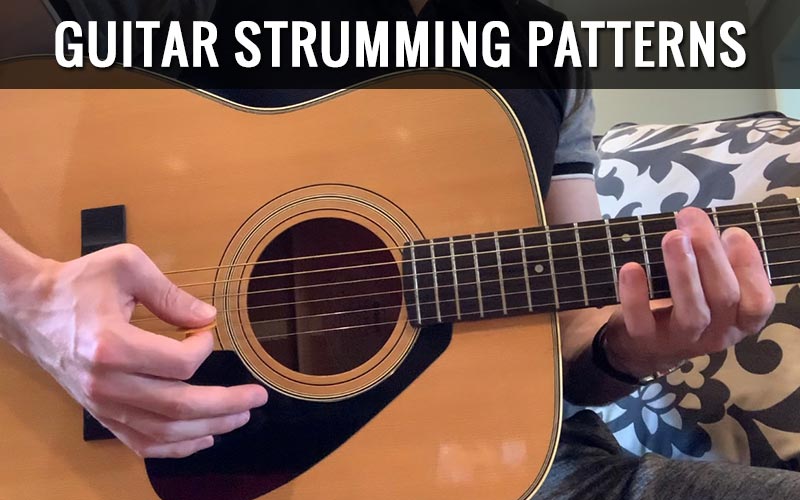
We will start off with basic rhythm styles for beginners, and move onto more complex patterns to help you build your strumming prowess. Let’s jump right in!
Here is a List of the Most Important Guitar Strumming Patterns
1. The 4-Beat Downstrokes
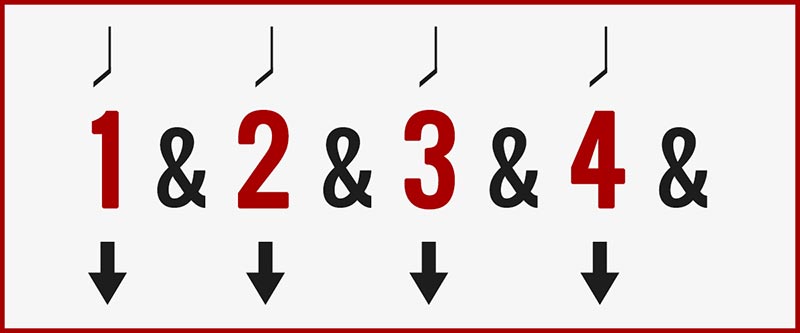
Difficulty Level: Easy
This is a really simple strumming part that is great for beginners. Since it’s so easy, it’s perfect for building your sense of timing and gaining confidence to move onto more complex strumming styles later.
How To Play: As you can see on the chart up there, you will be playing a downstroke (move your strumming hand down the strings) on every beat.
This means that you don’t do anything when counting the ‘and’ upbeat – playing a downstroke at 1, skipping ‘the and’ or the upbeat, then again playing a downstroke on 2, and skipping ‘the and’ or upbeat again – and so on and so forth.
You can start out by playing this style alongside a slow metronome beat that works for you, and slowly build up your speed to play it faster. But hey, don’t sacrifice accuracy for speed!
Songs That Use This Pattern: Check out the first 30 seconds of this song by Feme Vanille that uses the 4-beat downstroke. The track opens with haunting vocals that are accompanied by a simple 4-beat downstroke pattern on the guitar. This strumming pattern adds just the right amount of atmosphere to the song, without taking anything away from the singer’s beautiful vocals.
But if you think about it, you can use this strumming pattern to play most of the simple 4/4 songs that you still can’t get the exact strumming style for. Of course, you won’t be playing the way the guitar is actually strummed in the song, but you can still play the gist of it.
2. Add Two Upstrokes
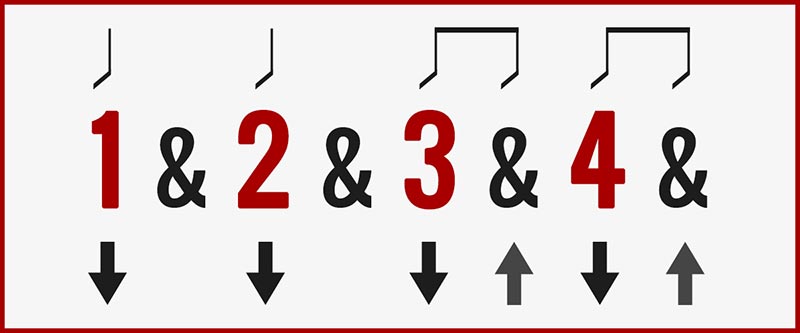
Difficulty Level: Intermediate
Once you get the hang of the 4-beat downstroke, let’s add some upstrokes to the mix, shall we? This one is slightly trickier to play compared to the first strumming style. But, if you pay attention to the chart, you’ll be fine.
This pattern is widely used by alternative rock bands, so this style will be quite useful if you like playing Alt-Pop.
How To Play: Pay close attention to the chart above. You can see two upstrokes introduced right after the 3rd and the 4th beat.
To play this pattern:
- You’ll continue playing a downstroke each on the 1st and the 2nd beat, like the 1st strumming pattern.
- But after playing the downstroke on the 3rd beat, quickly follow that up with an upstroke on the ‘and’ upbeat
- Do the same after playing the 4th note downstroke.
Songs That Use This Pattern: Check out the first 20 seconds of the track ‘Straight and Narrow’ by the band Teenage Fanclub. This feisty song makes great use of this strumming technique since it adds just the right amount of punch needed in the track. Give it a listen – the strumming pattern is quite clearly audible!
3. Add Three Upstrokes
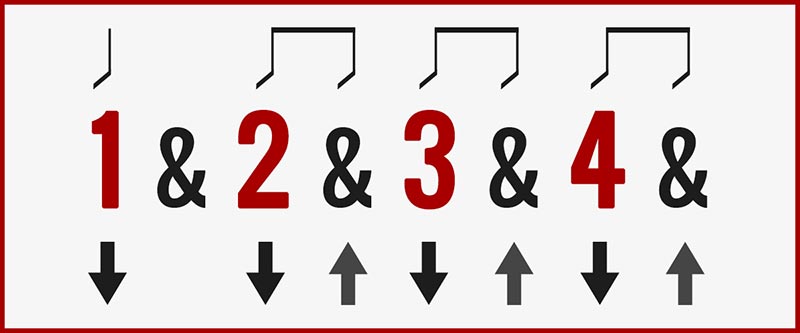
Difficulty Level: Intermediate
Once you’ve mastered adding two upstrokes into your pattern, let’s add another up to make it a total of three upstrokes into this strumming style! This 3 – upstroke strumming style is quite a versatile strumming style that can be used to play a variety of songs.
Depending on how fast or slow you play this strumming pattern, you can use it to add anything from indie rock to a straight-up pop vibe!
How To Play: This pattern is quite similar to the last one – the only difference is that you now play an upstroke right after the 2nd beat downstroke as well.
So, to put it simply – Play a downstroke on the first beat, skip the ‘and’, play a downstroke on the 2nd beat, and follow it up with an upstroke in the ‘and’ upbeat, and repeat this for the 3rd and the 4th beat as well.
Songs That Use This Pattern: Have you heard the track ‘Hey, Soul Sister’, by Train? That song uses this 3 – upstroke strumming pattern pretty much throughout the song!
However, this song requires you to play this pattern at a pretty high tempo, so it’s best to start out practicing it much slower than the original speed and make your way up to the original tempo. The strumming pattern is most obvious in the first 30 seconds of the song before the rest of the instruments kick in.
4. Downstroke On Downbeat, Upstroke On Upbeat
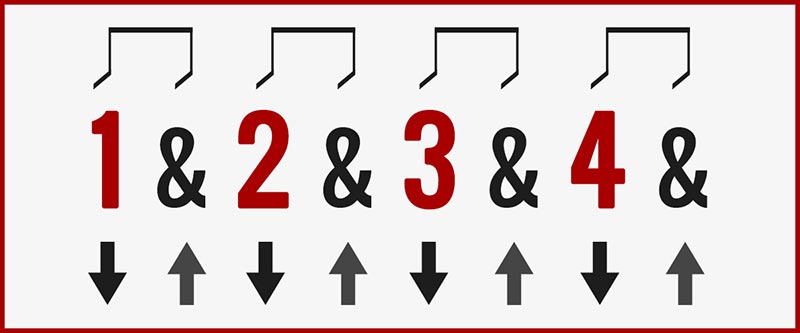
Difficulty Level: Easy
By now, you may have figured out that we are playing all the downstrokes on what we can call the ‘downbeat’ – on the 1,2,3, and 4. Meanwhile, the upstrokes are being played on what we call ‘the and’, or the ‘upbeat’ – in the space between 1,2,3, and 4 – always on the ‘and’. This particular strumming pattern is pretty easy to play once you’ve fully got the hang of playing upstrokes and downstrokes without pause.
How To Play: As you can see from the chart above, in this particular strumming pattern, we are playing downstrokes on all the downbeats, or during 1,2,3, and 4. And we are playing upstrokes on all the ‘and’ or upbeats that are between 1,2,3 and 4 beats.
What you get is a continuous strumming style that is fun to both play and listen to. As you can see, you’re only playing eighth notes in this strumming style, which is why this pattern is also called ‘Eight Note-Down, Up’. All the notes played here have a duration of 1/8th of the entire count – no quarter notes here.
Songs That Use This Pattern: The track ‘White Winter Hymnal’ by the band Fleet Foxes beautifully demonstrated this strumming style and shows how well it can be used to accompany a song. You can hear the guitarist clearly strumming this pattern right from the intro all the way till the 2-minute mark.
5. Skip One Downstroke
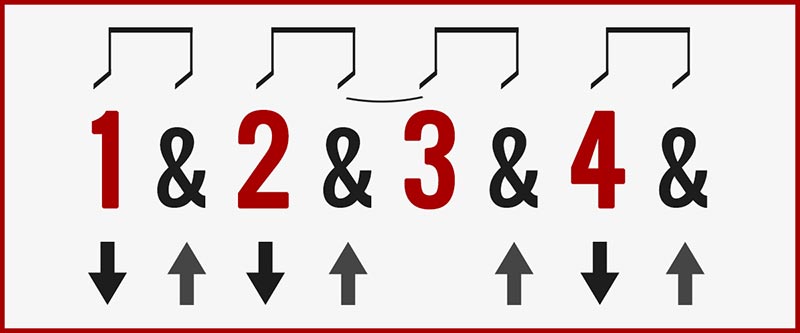
Difficulty Level: Medium to Advanced
If you practice the strumming patterns we’ve shared so far, you’ll get a great command over playing upstrokes and downstrokes continuously. Now, to round up your basic strumming technique and make it rock solid, let’s teach you something slightly tricky.
The patterns we shared so far have not required you to play one upstroke after another – there has always been a downstroke in the middle. With this particular style, we will break that rule!
How To Play: Take a look at the chart above – you can see that it is similar to Pattern no. 4 (Eighth note Down, Up), but with one big difference. You’ll notice that this pattern skips the downstroke on the 3rd downbeat. As a result, this pattern has down upstrokes one after the other, without a downstroke in between.
So, here’s how to do it:
- Play a downstroke with every downbeat, and an upstroke with every upbeat or ‘the and’. This happens consecutively, except for one skip in the middle.
- Except that you skip the downstroke on the 3rd downbeat and leave it blank.
Playing this particular strumming might feel a little odd and unnatural at first since you’re not as yet used to playing two upstrokes consecutively. But, with continuous practice, you’ll soon get the hang of it.
Mastering this pattern will train your mind to play more complex strumming styles in the future. That’s why, don’t rush when practicing this style – practice it at a slow tempo and build it up from there to faster speeds.
Songs That Use This Pattern: Check out the first minute or so of the song ‘This Mess We’re In’ by P.J. Harvey featuring the haunting, iconic vocals of Thom Yorke. Pay attention, and you’ll be able to hear this pattern, and also point out where the guitarist skips the downstroke on the 3rd downbeat.
This track is indeed following a pretty fast tempo, so we recommend slowing it down to 50% of its original speed on Youtube, and you’ll be able to clearly hear the strumming pattern and the skipped 3rd downbeat. We suggest starting out by practicing this song at 50% of its original speed and then slowly speeding up.
6. Skip An Upstroke & Downstroke
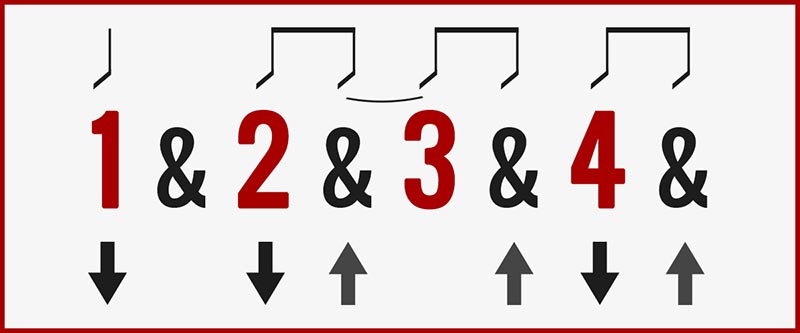
Difficulty Level: Medium to Advanced
This pattern has the same challenge as the previous one, with an added twist. We are not only skipping a downstroke, but also an upstroke. So this one might be slightly more challenging than the previous one, but you’ll be happy you learned it! It’s quite versatile and can be used to play a wide variety of songs belonging to different genres.
How To Play: If you look at the chart above, you’ll see that this pattern is similar to pattern no. 5, ie. you have to skip the downstroke on the 3rd downbeat. But along with that, you also have to skip the upstroke on the 1st upbeat, or the ‘and’ after the 1st downbeat.
To sum up:
- Play the downstroke on the 1st downbeat, skip the upbeat or the ‘and’.
- Play the downstroke on the 2nd downbeat, following up with an upstroke on the 2nd upbeat or ‘the and’.
- Then, skip the 3rd downbeat, and play an upstroke on 3rd upbeat or on ‘the and’.
- Finally, play the downstroke on the 4th downbeat and the upstroke on the following upbeat.
By learning to skip not just one but two strokes at different points of the strumming, will further solidify your rhythm prowess and knowledge.
Songs That Use This Pattern: Let’s give you two different examples of songs that have used this pattern, to show you its range.
The first is a sweet, romantic song written by Imaginary Future and Kina Garris. You can hear the pattern clearly right from the very beginning of the track – listen closely and you’ll hear the guitarist skipping the upstroke on the 1st upbeat, as well as skipping the downstroke on the 3rd downbeat. You can see how beautifully this pattern works for a slow, mellow track:
The 2nd track is the iconic ‘Hey Ya’ by legends ‘Outkast’. This track uses this strumming pattern through the duration of the song – from the very beginning all the way to the end. The absence of the skipped strokes is very obvious from the crystal-clear strumming.
Now, this track is way faster than our first example. But it serves as a great example to show you how the same strumming pattern, when played at different speeds, can add such different types of energy to the track.
7. The Pattern With A Long Pause
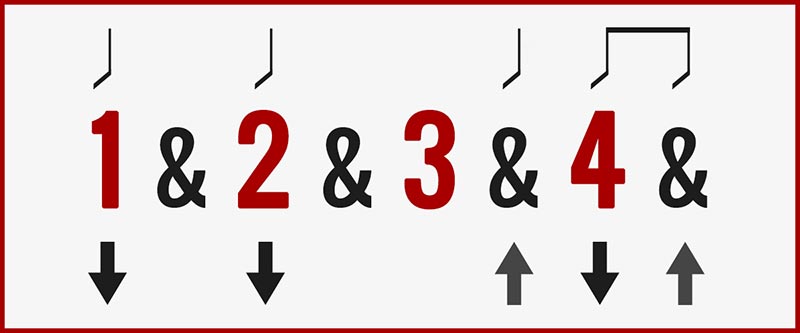
Difficulty Level: Advanced
Let’s take your strumming prowess one step further with this pattern. So far, all our patterns have required you to only skip one count or eighth note. But with this pattern, you’ll be skipping a whole quarter note – or two eighth notes. Such a strumming rhythm might not seem intuitive in the beginning. But don’t worry, we’ll take you exactly through how to do it.
How To Play: If you look at the chart, you’ll see that this pattern needs you to play fewer strokes than the other strumming styles – but don’t be fooled. Skipping these strokes can be tricky at first until you master it.
To play this, you have to:
- Skip the downstroke at the 1st upbeat or the ‘and’ right after the 1st downbeat.
- Then, play the downstroke at the 2nd downbeat.
- After that, here comes the long pause – skip not just the upbeat right after the 2nd downbeat, but also the 3rd downbeat.
- Then, play the upstroke at the 3rd upbeat, and alternate between downstroke on the 4th downbeat and upstroke on the 4th upbeat or the ‘and’.
The tricky part of this pattern is to keep your hand moving even you’ve paused between the 2nd and 3rd note. It might be tempting for you to simply stop moving your hand, but we’d suggest you keep your hand moving at all times, even when you’re not strumming the guitar! This will keep you strumming in a nice and steady natural flow.
Songs That Use This Pattern: Vance Joy’s chart-topping worldwide hit ‘Riptide’ opens with this strumming pattern, and plays it pretty much through the various verses – though it sounds the clearest in the intro and second verse. You’ll clearly hear the ukelele playing this strumming style.
This song plays this pattern at a somewhat high tempo throughout, so it might be a good idea to play it slowed out while trying to figure it out. We slowed the track down to 75% of its original speed on YouTube, and the strumming pattern was clearly audible in all its glory. Give it a try when practicing!
8. Ultimate Strum Pattern
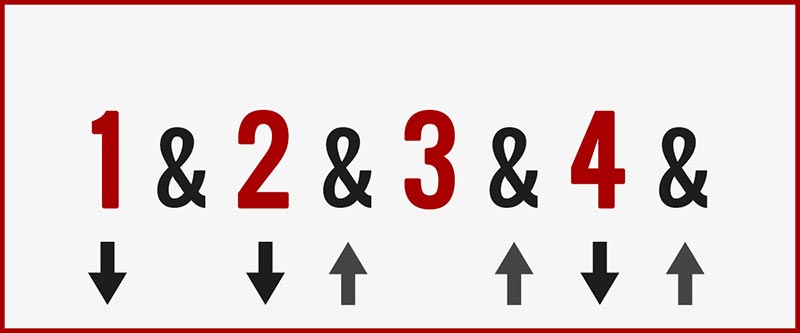
Difficulty Level: Medium to Advanced
There is a good reason why this pattern is nicknamed the ‘ultimate strum pattern’. It’s because it can practically be played with any chord progression, and is interesting enough to add a nice dimension to the track.
How To Play: As you can see from the chart above, this pattern requires you to skip one upstroke and a downstroke at different points of time.
- You start off with playing the downstroke on the 1st downbeat, and then skip the following ‘and’ or upbeat.
- Move onto playing the downstroke on the 2nd downbeat, followed by an upstroke at the ‘and’, or upbeat.
- Next, skip the downstroke on the 3rd downbeat, and play the upstroke on the next ‘and’.
- Finally, you round up by playing the down on the 4th downbeat, and upstroke on the next ‘and’ or upbeat.
As we said, this strumming pattern can be used in a variety of songs and chord progressions. But we would highly recommend that you take the time and effort to fully master this technique while playing only one chord before you add in more chords or complex progressions to the mix. This will ensure that your foundation is rock-solid.
Songs That Use This Pattern: How to save a life’ by The Fray is a phenomenal hit that’s known worldwide for its powerful and emotional songwriting. Well, this song is also the perfect example to demonstrate the Ultimate Strum guitar pattern as well!
We found a great guitar strumming tutorial of the song that will help you exactly see how to play this tricky but very cool rhythm pattern:
9. Indie Rock Strum Pattern

Difficulty Level: Advanced
This is a classic strumming pattern that’s widely used by indie rock bands for their tracks – such as ‘Save Tonight’ by Eagle Eye Cherry and ‘D’You Know What I Mean?’ By Oasis.
This strumming pattern is where you need to use your knowledge of 16th notes, so we have broken each stroke and pause down to 16 notes now. You’ll need to be solid with your knowledge of quarter, eighth and sixteenth notes, as well as have a grounding in playing the previous patterns to be able to play this pattern.
So, you’ll see that the beat that was previous divided as ‘1 and’, has now been further broken down into ‘1 – e – & – a’. This means that while two 8th notes make up a beat, it’s actually four 16th notes that make up a beat. Another new thing in this pattern is that, for the first time, you will be playing downstrokes on the ‘and’ upbeat, and not upstrokes. This is because we have expanded each beat to its four 16th notes, instead of two 8th notes.
How To Play: As you can see from the chart above, this pattern is pretty much all about the downstrokes, except for all the way at the very end. Since this guitar rhythm uses 16th notes as well, we have further fine-tuned our chart to not only show the 8th, but also the 16th notes – which is played for half the duration of the 8th note.
Playing instructions:
- Play the downstroke on the 1st downbeat, and skip the ‘e’. Play downstroke on the ‘and’ upbeat, and skip the ‘a’.
- Play another downstroke on the 2nd downbeat, again skipping the ‘e’. Play downstroke on the next ‘and’ or upbeat, and play an upstroke on the following ‘a’’ note.
- Play the downstroke on the 3rd downbeat, and skip the next ‘e’. Play downstroke on the following ‘and’ upbeat, and skip the next ‘a’.
- Play another downstroke on the 4th downbeat, skip the next ‘e’. Play a downstroke on the ‘and’ upbeat, and follow it with an upstroke on the ‘a’.
Songs That Use This Pattern: This acoustic guitar cover of ‘Dani California’ by Red Hot Chilli Peppers, performed by musician Joel Goguen is a great example of the Indie Rock strum pattern in action. Pay close attention to the first 45 seconds of the video, where you will see the pattern being played really clearly (the pattern changes in the chorus, so we’d say you ignore that for now).
We recommend slowing the video down to 50% or 75% of its original speed if you’re a beginner and need to clearly see and hear all the different strokes. If you listen and look closely, you’ll be able to see what we mean by playing the upstroke on the 4th upbeat lightly, and not playing it fully.
10. Modern Strumming

Difficulty Level: Advanced
So we are at the very end of our list, and we’re finishing up the list with the most advanced and trickiest strumming pattern to play out of all the rhythms shared here!
Just like in the indie rock strum pattern, this guitar pattern also requires you to have a rock-solid knowledge of how to play quarter, eighth and sixteenth notes. And once again, we have expanded our tab chart to divide each beat into four 16th notes. So, each beat is divided into ‘1-e-&-a’, and the same applies to the 2nd, 3rd, and 4th beat.
This is the toughest of all the strumming patterns we have shared so far, but it’s well worth learning this one! Once you get the hang of playing it smoothly on one chord, you can play it along with a chord progression of your choice.
How To Play: Follow the chart closely, and you’ll see that this pattern is slightly trickier to play than the indie-rock pattern, but we will get you through it. Here’s how to do it:
- Play a downstroke on the 1st downbeat, skip the ‘e’. Play another downstroke on the ‘&’ upbeat, and skip the ‘a’.
- Play a downstroke on the 2nd downbeat, and skip both the ‘e’ as well as the next ‘&’, and then play an upstroke on the ‘a’.
- Play a downstroke on the 3rd downbeat, an upstroke on the next ‘e’, another downstroke on the ‘&’, and skip the ‘a’.
- Play the downstroke on the 4th downbeat, skip the ‘e’. Then, play another downstroke on the ‘&’, and an upstroke on the ‘a’.
Songs That Use This Pattern: Check out this brilliant example of this strumming pattern, as Oasis plays an unplugged acoustic version of their iconic track ‘live forever. Slow the track down to 75% of its original speed if you like, and you will be able to clearly hear this guitar rhythm pattern.
Also, one of the advantages of this pattern is that it gives you the flexibility to tweak it the way you like, by improvising highlighting different 16th notes. You don’t have to stick to exactly playing this pattern on every bar on the song. And even in this video, you will notice that the guitarist doesn’t strictly stick to playing exactly this pattern all the time, and mixed it up a bit.
Here are some quick tips to keep in mind if you want to strum fluidly and naturally:
Don’t Stop Moving Your Strumming Hand: Make sure your hand is moving at all times, even if you’re not hitting the strings on certain beats. Constantly moving the hand will help your sense of timing, and you won’t have to worry about when to move the hand since it’s moving throughout.
Keep Your Hand And Wrist Loose: Take care to not lock your wrists – rather, keep the wrist nice and loose when strumming. Let the movement come from rotating the lower arm, with the wrist and hand staying loose and following that motion. This type of stance is also called the ‘drunken wrist’ since it’s so fluid!
Light Grip On The Pick: It’s not unusual to want to hold into your pick tightly, since you don’t want it slipping away. But holding it tightly may make it tough for the pick to slide smoothly across the strings.
So, hold your pick with a light grip so it easily slides over the strings. We recommend using a thin pick that’s nice and bendable while practicing strumming – though you can also try thicker picks if they suit you.
Don’t Have To Hit All Strings every time: You may feel that you have to hit all of the strings when strumming – but normally you end up hitting 3 to 4 strings with every strum.
A good rule to remember is to hit either all the strings or the first few thicker strings when playing the downstroke, and playing the thinnest 3-4 strings when playing the upstroke. This will give a nice dynamism to your strumming, and make it easier and fun to play too!
Practice With Just One Chord First: If you’re just starting out, we’d recommend practicing these strumming styles with only one chord, before moving on playing chord progressions. This will ensure that you’re able to play the pattern cleanly and accurately.
Why Should You Learn Guitar Strumming Patterns?
While new guitarists are often attracted to playing solos (well, they do look cool!), what they may not realize is that building a repertoire of strumming patterns is very important for their success as a musician, even if you’d like to eventually be a lead guitarist. Learning various strumming patterns can quickly expand the types of songs and musical styles you can play.
A fluid and skillful strumming technique is also crucial to building your sense of rhythm and motor coordination skills. So if you’d like to become an all-round guitarist with solid musicianship, we recommend practicing different strumming techniques to build a strong foundation.
Popular Related Article: Easy Guitar Songs to Learn
Guitar Strumming Basics
To understand the strumming patterns in this list, there are a few terms you should know:
The Downstroke: The downstroke refers to the downward motion of striking your pick from top to bottom of the strings – from the 6th (thickest) string, and moving down to the 1st (thinnest) string. This is indicated by ‘D’ or down symbol in our guide.
The Upstroke: The upstroke is the upward motion of your hand – starting from the 1st (thinnest string), up to the 6th (thickest) string. This is indicated by ‘U’ or up arrow symbol in our guide.
4/4 Time Signature: In this guide, we are using one bar count in a 4/4 time signature to explain the strumming styles. A 4/4 beat consists of 4 quarter notes that are equally spaced from each other, and we have named them 1,2,3, and 4 in our charts. A 4/4 beat sounds like this. Every cycle of 1,2,3, and 4 beats completes one bar count.
Quarter notes: The individual ‘beats’ you hear on the metronome in the video above are a quarter note. This means that it takes 4 quarter notes or 4 beats to make up 1 bar count that can be counted as 1-2-3-4, before repeating again.
This quick little video explains it really well:
Eighth Notes: Now, these quarter notes that make up a bar can be further divided into eighth notes. Each quarter is made up of 2 eighth notes – this means that it takes 2 eighth notes to fill up the same amount of time as 1 quarter note or 1 beat. So, instead of counting 1-2-3-4, we break it up as 1-&-2-&-3-&-4-&. It is illustrated in the following way:
Now, eighth notes can also be subdivided further into sixteenth notes! While 2 eighth notes make up a quarter note, 4 sixteenth notes make up a quarter note – this means that it takes 4 sixteenth notes to fill up the same amount of time as 1 quarter note or 1 beat. So, to count the sixteenth notes in a bar, we will say it as ‘1-e-&-a-2-e-&-a-3-e-&-a-&-e-&-a’. It is illustrated as the following:
Final Thoughts:
I hope this guide helps your strum your guitar like a full-on pro! Having a well-developed rhythm sense is crucial for the evolution of every guitarist, and it all starts by learning different strumming patterns. So take your time and build up your proficiency from the basic patterns, and with consistent practice, you’ll be moving up to the more advanced rhythm styles in no time. Happy playing!

My name is Chris and I’ve had a passion for music and guitars for as long as I can remember. I started this website with some of my friends who are musicians, music teachers, gear heads, and music enthusiasts so we could provide high-quality guitar and music-related content.
I’ve been playing guitar since I was 13 years old and am an avid collector. Amps, pedals, guitars, bass, drums, microphones, studio, and recording gear, I love it all.
I was born and raised in Western Pennsylvania. My background is in Electrical Engineering, earning a Bachelor’s degree from Youngstown State University. With my engineering experience, I’ve developed as a designer of guitar amplifiers and effects. A true passion of mine, I’ve designed, built, and repaired a wide range of guitar amps and electronics. Here at the Guitar Lobby, our aim is to share our passion for Music and gear with the rest of the music community.

Sorry but I am an old man just trying to learn to play guitar and I have never heard of any of the groups you say the strumming sounds come from. What can I do?
Thanks
Learn to listen and go step by step
your Way …. and always believe in you
I am up in age,trying to learn to play.I can not play by ear I have to see the lyrics and chords. I only use three fingers on the resting hand. Can you play with knowing only one pattern of strumming. I do know how to read music some what. Use tabs for some of my songs, not into blues or rock, or heavy metal. I like to pick the songs I want to play, country, old old gospel. And some up to date gospel. Songs I like that sound good and simple chords. Standard chords no power chords, use cypo to change key. Work out chords in that key by number system. What advise can you give. Please